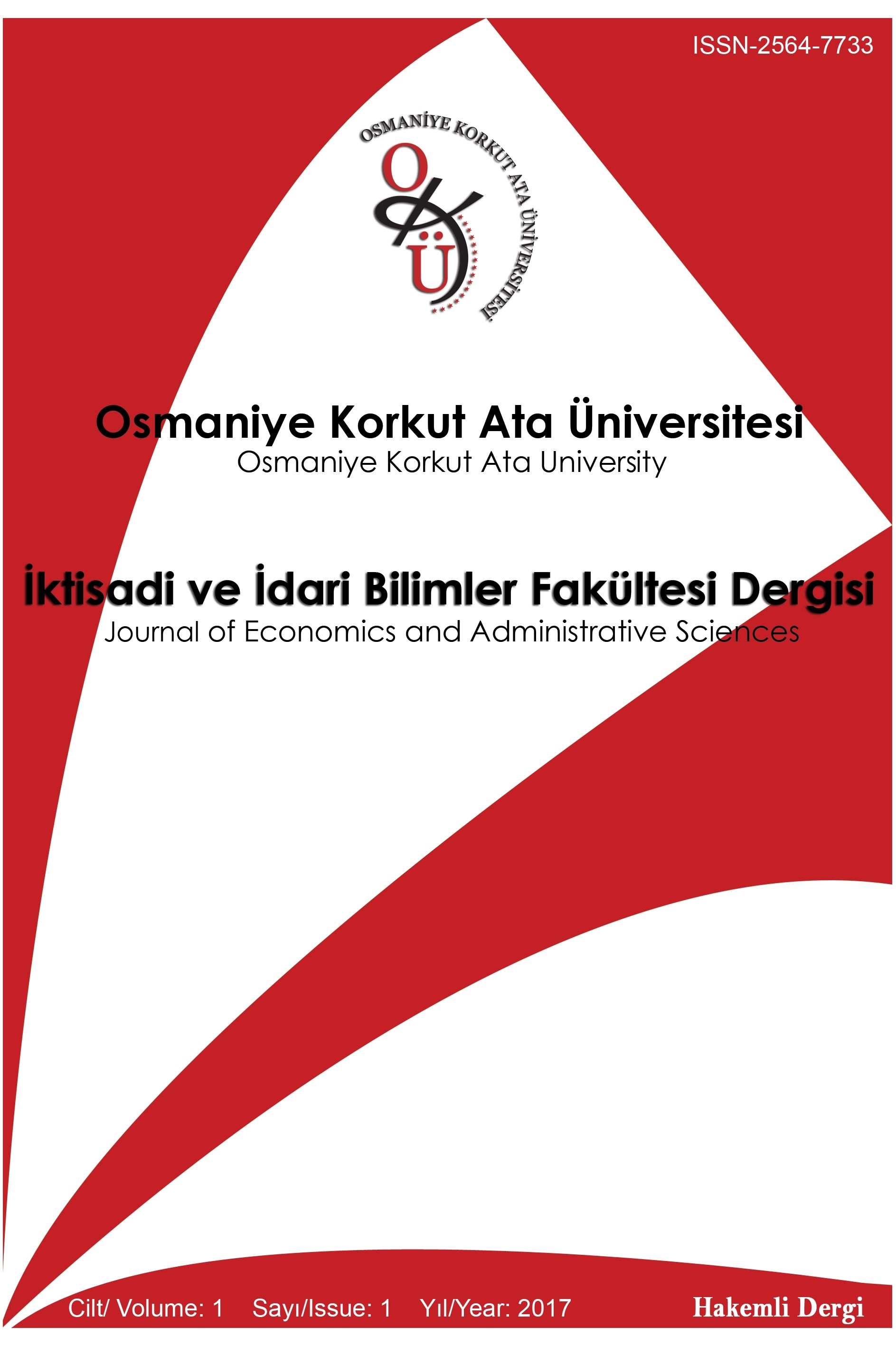TEDARİK ZİNCİRİ PERSPEKTİFİNDEN YENİLENEBİLİR ENERJİ KAYNAKLARI YÖNETİM STRATEJİLERİ ÜZERİNE BİR DEĞERLENDİRME
Yenilenebilir enerji tedarik zinciri, Biyokütle enerjisi, Hidroelektrik enerjisi, Jeotermal enerji, Güneş Enerjisi.
RENEWABLE ENERGY RESOURCES MANAGEMENT STRATEGIES FROM SUPPLY CHAIN PERSPECTIVE: PROBLEMS PERFORMANCE AND BARRIERS
Renewable energy supply chain, Biomass energy, Hydroelectric energy, Geothermal energy, Solar energy,
___
- Akkuş, İ. ve Alan, H. (2016). Türkiye’nin Jeotermal Kaynakları, Projeksiyonları, Sorunlar ve Öneriler Raporu, Ankara: TMMOB Jeoleji Mühendisleri Odası.
- An, H., Wılhelm, W. E., ve Searcy, S. W. (2011). A mathematical model to design a lignocellulosic biofuel supply chain system with a case study based on a region in Central Texas. Bioresource Technology, 102 (17), 7860-7870.
- Bahadori, A., Zahedi, G., ve Zendehboudi, S. (2013). An overview of Australia's hydropower energy: Status and future prospects. Renewable and Sustainable Energy Reviews, 20, 565-569.
- EIA. (2018). “What is renewable energy?”. https://www.eia.gov/energyexplained/index.php?page=renewable_home#tab1, 28.01.2019.
- EİGM. (2018). “2017 Yılı Genel Enerji Denge Tablosu”, http://www.eigm.gov.tr/tr-TR/Sayfalar/2017Yili-Ulusal-Enerji-Denge-Tablolari, 28.01.2019.
- ETKB. (2018). “Rüzgar”, http://www.enerji.gov.tr/tr-TR/Sayfalar/Ruzgar, 29.01.2019.
- Greenmatch (2018). “Advantages and Disadvantages of Geothermal Energy - The Source of Renewable Heat”, https://www.greenmatch.co.uk/blog/2014/04/advantages-and-disadvantages-of-geothermal-energy, 29.01.2019.
- Hamelinck, C, Suurs, R. A. A. ve Faaij, P.C. (2005). International bioenergy transport costs and energy balance. Biomass and Bioenergy, 29, 114-134.
- He, Y., ve Chen, X. (2009). Wind turbine generator systems. The supply chain in China: Status and problems. Renewable Energy, 34 (12), 2892-2897.
- Hoogwijk, M., Faaij, A., Broek, R. V. D., Berndes, G., Gielen, D., ve TurkenburG, W. (2003). Exploration of the ranges of the global potential of biomass for energy. Biomass and Bioenergy, 25 (2), 119-133.
- Jassim, H. (2013). Geothermal energy and possibility use it in Iraq. The Islamic College University Journal, 8 (25), 193-213.
- Kannan, N., ve Vakeesan, D. (2016). Solar energy for future world: A review. Renewable and Sustainable Energy Reviews, 62, 1092-1105.
- Kessides, I. N. (2013). Chaos in power: Pakistan’s electricity crisis. Energy Policy, 55, 271-285.
- Khan, A. A. (2009). Potential to use biomass for bio-energy in Ontario. Guelph Engineering Journal, 2, 39-44.
- Mafakheri, F. ve Nasiri, F. (2014). Modeling of biomass-to-energy supply chain operations: Applications, challenges and research directions. Energy Policy, 67, 116-126.
- Menz, F. C., ve Vachon, S. (2006). The effectiveness of different policy regimes for promoting wind power: Experiences from the states. Energy policy, 34 (14), 1786-1796.
- Mun, K. G. (2016). Designing Energy and Water Supply Chains for Prosperity, Doctorate Thesis, The State University of New Jersey, New Jersey.
- Özgür, E. (2018). “Türkiye’de Güneş Enerjisi”, Türkiye’de Enerji Görünümü 2018, Ankara: TMMOBREN21. (2018). “Renewables 2018 Global Status Report”, Renewable Energy Policy Network for the 21st Century.
- Saavedra, M. R., Fontes, C.H. ve Freires, G. M. (2018). Sustainable and renewable energy supply chain: A system dynamics overview. Renewable and Sustainable Energy Reviews, 82, 247-259.
- Searcy, E., Flynn, P., Ghafoori, E., ve Kumar, A. (2007). The relative cost of biomass energy transport. Applied Biochemistry and Biotechnology, 7/136-140, 639-652.
- TEİAŞ. (2018a). “2017 Yılı Türkiye Elektrik Enerjisi Üretiminin Kaynaklara Göre Dağılımı”, https://www.teias.gov.tr/tr/iii-elektrik-enerjisi-uretimi-tuketimi-kayiplar-0, 28.01.2019.
- TEİAŞ. (2018b). “Türkiye Elektrik Sistemi Kuruluş ve Kaynaklara Göre Kurulu Güç”, https://www.teias.gov.tr/sites/default/files/2019-01/kurulu_guc_aralik_2018.pdf, 28.01.2019.
- TMMOB. (2017). “Türkiye Enerji Görünümü Eylül 2017”. https://www.mmo.org.tr/sites/default/files/TURKIYE%20ENERJ%C4%B0%20G%C3%96R%C3%9CN%C3%9CM%C3%9C_EYL%C3%9CL%202017%20%281%29.pdf, 29.01.2019.
- WEC. (2016). “World Energy Resources Geothermal 2016”.
- Wee, H. M., Yang, W. H., Chou, C. W., ve Padilan, M. V. (2012). Renewable energy supply chains, performance, application barriers, and strategies for further development. Renewable and Sustainable Energy Reviews, 16 (8), 5451-5465.
- WWEA. (2018). “Wind Power Capacity Reaches 539 GW, 52,6 GW Added in 2017”, http://wwindea.org/blog/2018/02/12/2017-statistics/, 29.01.2019.
- YEGM. (2018). “Biyokütle Çevrim Teknolojileri”, http://www.yegm.gov.tr/yenilenebilir/biyokutle_cevrim_tekno.aspx, 28.01.2019.
- Yüksel, I. (2010). Hydropower for sustainable water and energy development, Renewable and Sustainable Energy Reviews, 14, 462-469.
- ISSN: 2564-7733
- Yayın Aralığı: Yılda 2 Sayı
- Başlangıç: 2017
- Yayıncı: Osmaniye Korkut Ata Üniversitesi
BÜYÜK VE ORTA BÜYÜKLÜKTEKİ İŞLETMELER İÇİN GETİRİLEN FİNANSAL RAPORLAMA STANDARTLARININ ETKİLERİ
ÜRETİM SİSTEMLERİNDE BİR SİMÜLASYON UYGULAMASI
BURSA'NIN KENTSEL YAPI KÜLTÜRÜNDEKİ DÖNÜŞÜM
YALIN ÜRETİM SİSTEMLERİ İÇİN BİR ALTERNATİF MALİYETLEME SİSTEMİ: DEĞER AKIŞ MALİYETLEME
Faruk KAYGUSUZ, Veyis Naci TANIŞ
Mutlu Yüksel AVCILAR, Mehmet Fatih AÇAR
MEDIATING ROLE OF PERSON-ORGANIZATION FIT IN PERSON-JOB FIT'S EFFECT ON JOB SATISFACTION
X VE Y KUŞAKLARININ İŞ-YAŞAM DENGELERİNİN DEMOGRAFİK FAKTÖRLER AÇISINDAN İNCELENMESİ
Şeyma Gün EROĞLU, Demet AKOĞLU
ÜNİVERSİTE ÖĞRENCİLERİNİN İNTERNET BAĞIMLILIK DÜZEYLERİ ÜZERİNE BİR ÇALIŞMA
ANADOLU’DA DEMİRYOLLARININ ORGANİZASYONU: TARİHSEL BİR ANALİZ
ÇALIŞANLARIN İŞ GÜVENCESİZLİĞİNİN DUYGUSAL EMEK VE İÇ GİRİŞİMCİLİK ÜZERİNE ETKİSİ
